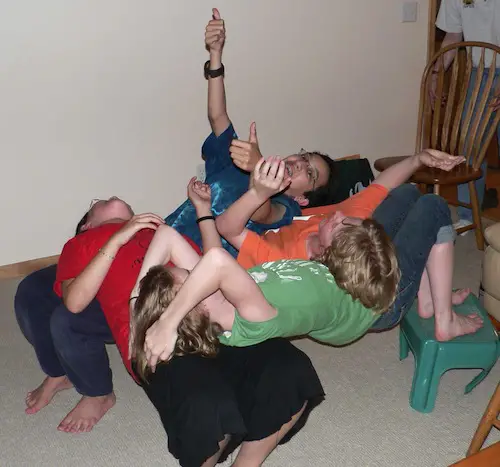Summary: Human Sculptures (also known as Human Clay) is an icebreaker group game that involves posing people into large human sculptures based on predefined topics. Two versions exist: a competitive version based on a guessing game, and a version that is more about coming up with a creative interpretation.
Ages: 12 and up. Recommended number of people: Groups of at least three. Messiness factor: Minimal – hold a pose for a few minutes. Materials required: Sheets of paper and pens. Recommended setting: Indoors or outdoors.
Human Sculptures Game
Human Sculptures is a fun game that be used as an icebreaker activity or as a general party game. There are two variations of this game — one version is a competitive guessing game, while the other version is an based on creative interpreptations of various topics. The instructions for both versions are below.
How to Play Human Sculptures: Guessing Game VersionThe facilitator should announce a category (e.g. famous movies or famous songs — the more specific the better). All players are then divided into smaller groups and one team leader is given a pen and paper. Each group brainstorms an idea that goes along with the topic and each team leader must write down the idea on a sheet of paper and turn it in to the leader, who checks that the idea is appropriate for use. Each group then creates a sculpture using their bodies. Every member of the group should comprise some part of the entire sculpture. After a predefined time limit (for example, five minutes), each team looks at each other’s sculpture. Each team is allowed two guesses for what the other team has formed. Whatever group guesses the the other group’s sculpture the closest is the winner.
How to Play Human Sculptures: Noncompetitive Version
The leader should announce that the group will now participate in a “human clay” activity. Players would be asked to provide their own interpretation or illustration of some category of events or other topics (prepared in advance by the leader). Some examples of categories that could be used:
- A topic related to specific subject matter learned in the classroom
- An important event or experience
- An important event in history
- An famous scene from a movie
- A line from a famous song
The leader should demonstrate first (to help put the players at ease, especially those who might be reluctant to act out). This noncompetitive version can be a good way to see how people illustrate content learned in class, or something personally meaningful to them. Have fun!
